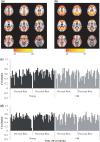Age differences in the default network at rest and the relation to self-referential processing
- PMID: 24652859
- PMCID: PMC4321621
- DOI: 10.1093/scan/nsu046
Age differences in the default network at rest and the relation to self-referential processing
Abstract
Older adults show a 'positivity bias' in tasks involving emotion and self-referential processing. A critical network that is involved in self-referencing and shows age-related decline is the default network (DN). The purpose of the current study was to investigate age differences in pre- and post-task DN functional connectivity (FC) and signal variability, and to examine whether they are predictive of the positivity bias in self-referencing. We measured FC and within-subject variability of the DN in resting-state scans preceding and following tasks involving personality judgements on the self and a close other. Older adults endorsed more positive traits than younger adults on both tasks. FC was weaker post-task in older vs younger adults, and younger adults had greater variability than older adults in DN nodes. Younger adults with higher post-task DN variability had more negative self-ratings. For both age groups, greater FC in the DN was associated with more negative self-ratings. Neither FC nor variability was related to other ratings, despite the potential for self-processing when making other judgements. Our findings suggest that ageing leads to reduced FC and variability in the DN, which is most apparent after task, and may be one mechanism underlying the positive bias with age.
Keywords: ageing; default network; positivity effect; resting state; self-referential processing.
© The Author (2014). Published by Oxford University Press. For Permissions, please email: journals.permissions@oup.com.
Figures




References
-
- Addis DR, McIntosh AR, Moscovitch M, Crawley AP, McAndrews MP. Characterizing spatial and temporal features of autobiographical memory retrieval networks: a partial least squares approach. NeuroImage. 2004;23:1460–71. - PubMed
-
- Anderson N. Likeableness ratings of 555 personality trait adjectives. Journal of Personality and Social Psychology. 1968;9:272–9. - PubMed
Publication types
MeSH terms
Grants and funding
LinkOut - more resources
Full Text Sources
Other Literature Sources
Medical

